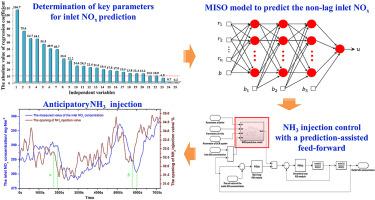Journal of the Energy Institute ( IF 5.6 ) Pub Date : 2020-07-27 , DOI: 10.1016/j.joei.2020.07.002 Guofu Liu , Yu Zhang , Dekui Shen , Bing Yuan , Rui Li , Yu Sun

|
The anticipatory NH3 injection control strategy with a prediction-assisted feed-forward was proposed to improve the accuracy of the outlet NOx control. The large lag of SCR system was ascribed to the lag duration by flue gas sampling for inlet NOx analysis. A 660 MW power plant equipped tangentially fired pulverized coal boiler was involved in the process of theoretical analysis and engineering application. 22 key running parameters of the studied power plant were determined to influence the inlet NOx concentration of SCR system substantially through the multiple linear regression (MLR) method. Multiple input single output (MISO) model was adopted to predict the non-lag inlet NOx concentration based on a multi layer perception (MLP) model with three hidden layers. An optimization strategy for MISO model application was proposed to improve the prediction accuracy of inlet NOx concentration. The root mean square error (RMSE) was decreased to be 5.52 mg·Nm−3 and the mean absolute percentage error (MAPE) was only 1.12%. The maximum absolute deviation was also decreased by 41.28% compared with the deviation in the direct application case. The average constant control deviation (CCD) of the outlet NOx concentration was calculated to be 2.27 mg·Nm−3 in the case analysis of engineering application. The technology can be developed as a potential strategy for improving the NH3 injection performance of SCR system.
中文翻译:

基于进口NO x浓度预测的SCR系统预期NH 3喷射控制
提出了具有预测辅助前馈的预期NH 3喷射控制策略,以提高出口NO x控制的准确性。SCR系统的较大的滞后是归因于通过烟道气采样为入口NO滞后持续时间X分析。配备切向燃烧粉煤锅炉的660兆瓦电厂参与了理论分析和工程应用。被确定为影响所述入口NO所研究的电厂的22个关键运行参数X基本上通过多重线性回归(MLR)方法SCR系统的浓度。采用多输入单输出(MISO)模型来预测无滞后入口NO x基于具有三个隐藏层的多层感知(MLP)模型进行集中。提出了MISO模型应用的优化策略,以提高进口NO x浓度的预测精度。均方根误差(RMSE)降低到5.52 mg·Nm -3,平均绝对百分误差(MAPE)仅为1.12%。与直接应用的情况相比,最大绝对偏差也减少了41.28%。在工程应用的案例分析中,出口NO x浓度的平均恒定控制偏差(CCD)计算为2.27 mg·Nm -3。可以将该技术开发为改善NH 3的潜在策略 SCR系统的喷射性能。











































 京公网安备 11010802027423号
京公网安备 11010802027423号